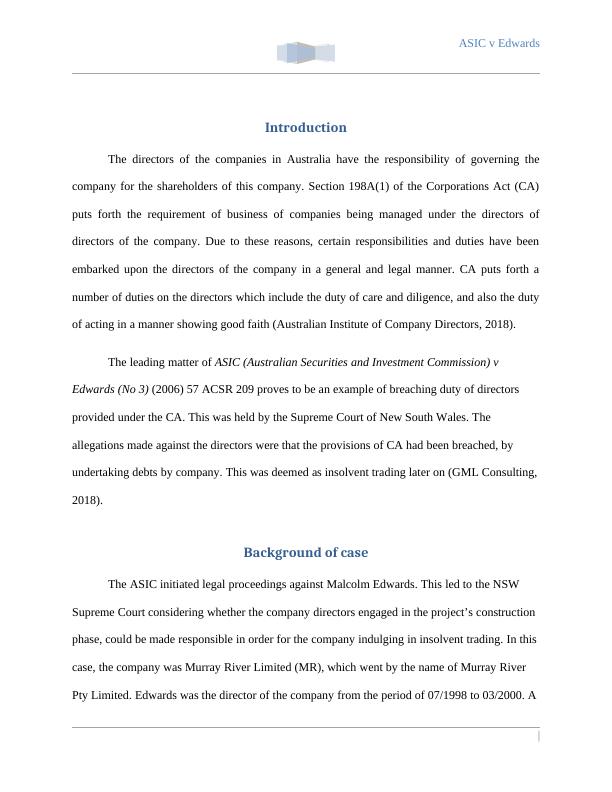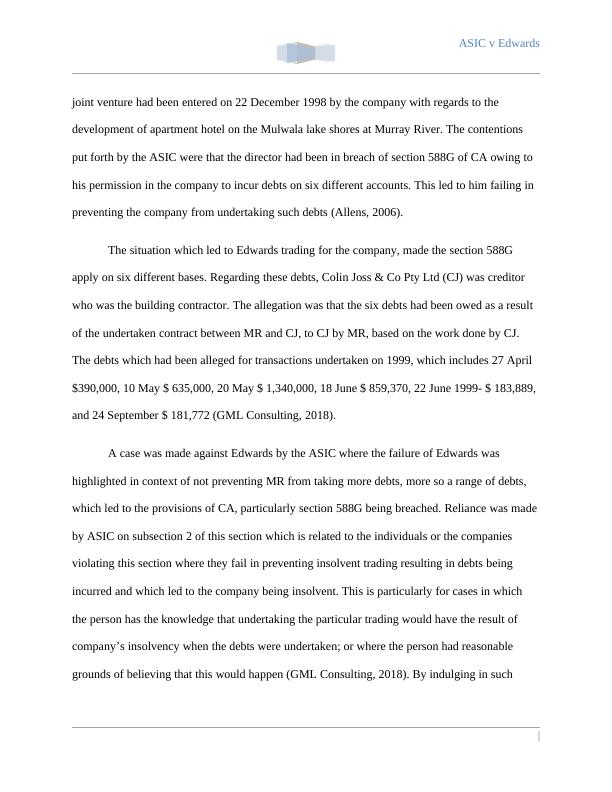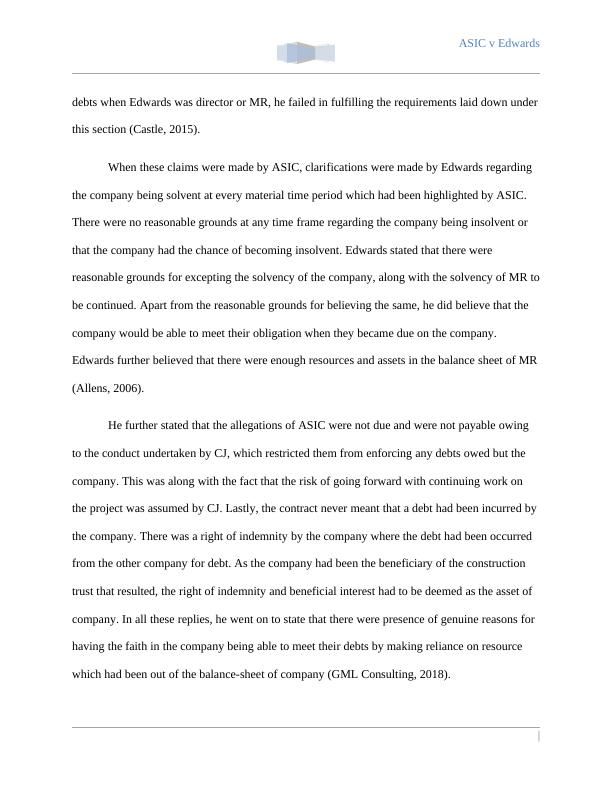Business and Corporations Law Assignment
11 Pages2685 Words99 Views
Added on 2020-05-16
Business and Corporations Law Assignment
Added on 2020-05-16
ShareRelated Documents
ASIC v Edwards |

ASIC v EdwardsIntroductionThe directors of the companies in Australia have the responsibility of governing thecompany for the shareholders of this company. Section 198A(1) of the Corporations Act (CA)puts forth the requirement of business of companies being managed under the directors ofdirectors of the company. Due to these reasons, certain responsibilities and duties have beenembarked upon the directors of the company in a general and legal manner. CA puts forth anumber of duties on the directors which include the duty of care and diligence, and also the dutyof acting in a manner showing good faith (Australian Institute of Company Directors, 2018).The leading matter of ASIC (Australian Securities and Investment Commission) v Edwards (No 3) (2006) 57 ACSR 209 proves to be an example of breaching duty of directors provided under the CA. This was held by the Supreme Court of New South Wales. The allegations made against the directors were that the provisions of CA had been breached, by undertaking debts by company. This was deemed as insolvent trading later on (GML Consulting,2018). Background of caseThe ASIC initiated legal proceedings against Malcolm Edwards. This led to the NSW Supreme Court considering whether the company directors engaged in the project’s construction phase, could be made responsible in order for the company indulging in insolvent trading. In this case, the company was Murray River Limited (MR), which went by the name of Murray River Pty Limited. Edwards was the director of the company from the period of 07/1998 to 03/2000. A |

ASIC v Edwardsjoint venture had been entered on 22 December 1998 by the company with regards to the development of apartment hotel on the Mulwala lake shores at Murray River. The contentions put forth by the ASIC were that the director had been in breach of section 588G of CA owing to his permission in the company to incur debts on six different accounts. This led to him failing in preventing the company from undertaking such debts (Allens, 2006).The situation which led to Edwards trading for the company, made the section 588G apply on six different bases. Regarding these debts, Colin Joss & Co Pty Ltd (CJ) was creditor who was the building contractor. The allegation was that the six debts had been owed as a result of the undertaken contract between MR and CJ, to CJ by MR, based on the work done by CJ. The debts which had been alleged for transactions undertaken on 1999, which includes 27 April $390,000, 10 May $ 635,000, 20 May $ 1,340,000, 18 June $ 859,370, 22 June 1999- $ 183,889, and 24 September $ 181,772 (GML Consulting, 2018). A case was made against Edwards by the ASIC where the failure of Edwards was highlighted in context of not preventing MR from taking more debts, more so a range of debts, which led to the provisions of CA, particularly section 588G being breached. Reliance was madeby ASIC on subsection 2 of this section which is related to the individuals or the companies violating this section where they fail in preventing insolvent trading resulting in debts being incurred and which led to the company being insolvent. This is particularly for cases in which the person has the knowledge that undertaking the particular trading would have the result of company’s insolvency when the debts were undertaken; or where the person had reasonable grounds of believing that this would happen (GML Consulting, 2018). By indulging in such |

ASIC v Edwardsdebts when Edwards was director or MR, he failed in fulfilling the requirements laid down underthis section (Castle, 2015). When these claims were made by ASIC, clarifications were made by Edwards regarding the company being solvent at every material time period which had been highlighted by ASIC. There were no reasonable grounds at any time frame regarding the company being insolvent or that the company had the chance of becoming insolvent. Edwards stated that there were reasonable grounds for excepting the solvency of the company, along with the solvency of MR tobe continued. Apart from the reasonable grounds for believing the same, he did believe that the company would be able to meet their obligation when they became due on the company. Edwards further believed that there were enough resources and assets in the balance sheet of MR(Allens, 2006). He further stated that the allegations of ASIC were not due and were not payable owing to the conduct undertaken by CJ, which restricted them from enforcing any debts owed but the company. This was along with the fact that the risk of going forward with continuing work on the project was assumed by CJ. Lastly, the contract never meant that a debt had been incurred by the company. There was a right of indemnity by the company where the debt had been occurred from the other company for debt. As the company had been the beneficiary of the construction trust that resulted, the right of indemnity and beneficial interest had to be deemed as the asset of company. In all these replies, he went on to state that there were presence of genuine reasons for having the faith in the company being able to meet their debts by making reliance on resource which had been out of the balance-sheet of company (GML Consulting, 2018). |

End of preview
Want to access all the pages? Upload your documents or become a member.
Related Documents
ASIC v Edwards Assignment PDFlg...
|8
|2343
|120
Corporations Law : Assignment Samplelg...
|6
|1197
|54
Groeneveld Australia Pty Ltd Assignment PDFlg...
|7
|2225
|45
HI6027 Assignment on Business & Corporations Lawlg...
|10
|2506
|115
Action taken by liquidator against directors for insolvent tradinglg...
|5
|1060
|73
Corporations Law : Assignmentlg...
|10
|2633
|108
